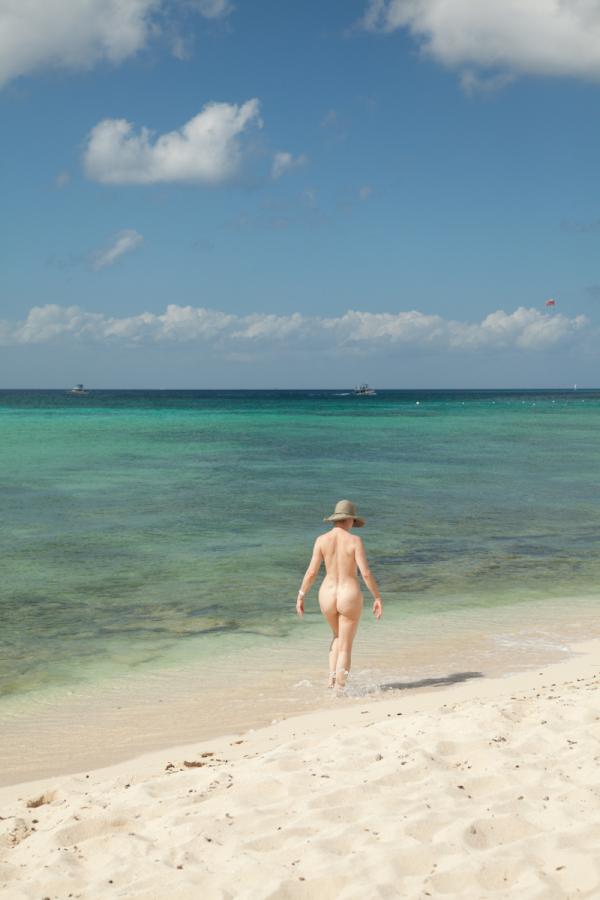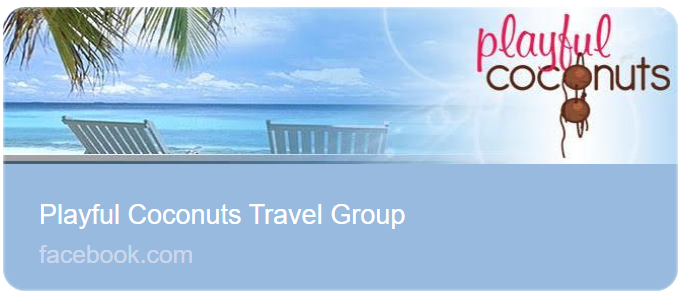 Naked in St. Lucia
Naked in St. Lucia
By Sue McGarvie and Blaik Spratt
Clinical Relationship Therapists, Syndicated Talk Show Host
As keynote speakers and therapists, we are often asked to suggest shared sensuous activities for couples. We always recommend exploring nudity for the first time. However try explaining to non- nudists about the appeal of being naked. Maybe if you have to explain it to someone, they never will truly understand it. For us, it is the pleasure seeking sensation of wind across your skin, the free feeling of being naked outside, or the complete avoidance of uncomfortable, wet, sandy, bathing suits. Either way finding places where you can be naked outside is one of life’s great quests.
We consider ourselves as much romantic adventurers as we do die hard nudists. We are busy finding new places to explore, and then make it our mission to locate the places where you can “drop the laundry”. So when we had an opportunity to visit St. Lucia, we packed lightly and made a point to source out opportunities to be naked. It may be fun to be surrounded by thousands of other like-minded naturists, but we discovered St. Lucia can allow you to be quietly naked, which has its own appeal.
St. Lucia, like all the Caribbean Islands, has a flavor all its own. St. Lucia is a small, primarily Catholic country of 150,000 friendly, but reserved people, with no advertised nude beaches. According to all the trip advisors we read in anticipation of the trip, nudity is not allowed anywhere on the island, and thus we expected to be clothed for the duration of the vacation. We also read that St. Lucia is a spectacularly beautiful place of waterfalls, rainforests, volcanic hot springs, and amazing scenery. At least the internet postings got that right.
St. Lucia is lush, green, and covered in flowering shrubs and multi-colored hummingbirds – even during the dormant season when we were there. As throughout the southeastern Caribbean, you get warm days and nights in the 28-31 Celsius range almost year round, and can expect small cloud bursts occasionally through the day. St. Lucia has a rich history of pirates, French guillotines, banana plantations and a mix of French and English cultures. Both France and England battled for the island (and each won seven times, with England winning the last bout), and although English is the official language, the locals speak a Creole dialect mix of French and English called patois which was fun to listen to.
Most of St. Lucia is mountainous and covered in jungle. The whole island is only 29 miles long, but you can expect driving the length of it to take over two hours. The roads are switch back and a bit of a roller coaster ride- especially along the west side of the island. Bring your Gravol or other travel-sickness medication if you are driving around the island much. We read one report that suggested that “St. Lucia allows you to get in touch with your calf muscles” which we found to be oh, so true. Almost everything in St. Lucia is uphill or downhill (although it seems more like uphill), and everyone is expected to climb flights of stairs. It’s not a great destination if you are ambulatory challenged.
The capital, Castries in the north is home to 50,000 people, shopping and a number of destination spas and resorts such as Sandals and Almond resorts. Further southward down the western coastline near the town of Soufriere lay the Pitons. The Pitons, are two volcanoes that UNESCO has deemed a world heritage site. We visited three resorts in Soufriere, overlooking the Pitons and the view rivaled anywhere we’ve ever been. What makes the view so magnificent is that resorts in Soufriere are built with only three walls and only a shade canopy to the block the sun where the fourth wall should be. That means open air in all the rooms, dining and common areas. It is a very different concept, and one of the few places in the world that has limited bugs, few mountainous creepy or slithering things, warm weather, is sheltered somewhat from hurricanes and tropical storms and is relatively crime-free and difficult to access along the mountain-side. You can sleep naked while feeling like you are completely outdoors, albeit the bed is covered in mosquito netting. During the day you can move back and forth without wearing a stitch between the luxurious comfort of a five star appointed room, and the outside while enjoying the delights of sun tanning, swimming, and bird watching within your own large, villa-like room. It’s like fantasy camping.
The three Soufriere area resorts we stayed at; Jade Mountain, its sister resort Anse Chastanet, as well as Ladera all had these three walled, open concept rooms, complete with their own large splash pools (about a third of the size of a regular pool). You could watch the stars from your king sized bed, or feed the birds, naked at the edge of the pool. It was absolute bliss to be naked 24/7, in and out of the pool with all the amenities of a hotel room.
Jade Mountain is a one-of –a-kind resort (partnered with the older, but quaint Anse Chastanet). We discovered that Jade Mountain is about beauty, nature, modern art and architecture all blended into jaw dropping scenery. Located on the edge of a marine reserve, the snorkeling and diving is said to be tremendous. With only 29 rooms, and only three years old, Jade Mountain is the uniquely designed specialty resort by Canadian architect Nick Troubetzkoy. He had been running Anse Chastanet (the less expensive but delightful family resort again with the great open aired rooms for nudist families) for 30 years, before he built the uniquely designed, secluded, adult romance gourmet destination of Jade Mountain.
The quality of the food at Jade Mountain/Anse Chastanet can’t be over emphasized. Jade Mountain boasts an American Academy of Hospitality Sciences five star rating for food and service. Much of the organic produce for both Jade and Anse Chastanet is grown on the owner’s surrounding 600 acre plantation including mangoes, spices, and chocolate used in their so named culinary festivals. We had grilled snapper followed with homemade rum and raisin ice cream for dessert that instantly became a most unforgettable meal. By day two the staff had an understanding of our food and beverage preferences, and was suggesting a favorite tea. With English Butler Academy trained butlers (they call them major-domos) at your service to fulfill any need, the attention to detail was superb. The Guild of English Butlers means that these professional hoteliers can unpack for you, arrange for your favorite foods at preferred tables, acquire hard to find items, and aid in travel arrangements. Given the service, and the privacy allowed in the sanctuaries (as these open-aired rooms are called) you could spend your entire vacation naked if your intention was to just relax and unwind.
Ladera, the other resort we stayed at in Soufriere was voted the #1 hotel in the world in 2005 by Conde Nast readers. Again, they had these great open-aired villa-rooms with splash pools. Their slogan is “a view with a room”. An interesting feature of this hotel was the multiple bedroom villas. Two or three couples could share the villa and enjoy the benefits of communal nudity (while splitting some costs).
Soufriere boasts hot springs and sulfuric mineral springs and waterfalls in the area. It looked just like muddy water, but it is rumored to have healing properties, and was originally built for the troops of King Louis XVI of France. They are relaxing, and offer some privacy for nude bathing if you are discreet.
After lots of relaxation in Soufriere, we headed to the south part of the island for adventure and beach living. We landed at Coconut Bay, the largest resort in St. Lucia at over 300 rooms. We stayed on the adult-only Harmony side that had an outstanding spa with private showers for two, and an acceptance of topless sunbathing. We asked a number of locals about nude beaches, and they all laughed and said that there were a number of private beaches on the east and south coasts of the island available for nude sun tanning. One of the young women who worked at the resort said “she almost never wore a bathing suit when on the beach near her family’s home”. She said “to ask the locals”, they know where to go. Apparently the water taxi drivers have a few secluded places they can take you for a nude day at the water’s edge, but they don’t recommend going alone “as there has been some theft of clothing and money when left unattended”.
St. Lucia is a quieter, more relaxed nude holiday. The island can be more expensive than some of the other Caribbean islands, but it is a classy, cultural, and elegant destination for nudists looking for a new adventure.
 Like many people my friend D’s worry about being naked for the first time was being seen by someone she knew. The “what if I run into someone from the office and they see all of me” keeps lots of people from enjoying nature- without a bathing suit.
Like many people my friend D’s worry about being naked for the first time was being seen by someone she knew. The “what if I run into someone from the office and they see all of me” keeps lots of people from enjoying nature- without a bathing suit.


 There is a quote on the door of the outhouse at a nude camp in Canada that goes something like this:
There is a quote on the door of the outhouse at a nude camp in Canada that goes something like this:
 Naked in St. Lucia
Naked in St. Lucia Naked and Green
Naked and Green



 One of our most vivid memories of our first trip to Hedonism stared in the SuperClubs holding room in the Montego Bay Airport. We were handed a bottle of water and asked where we were going. Hedonism 2 was our tentative answer. “Ah the Zoo” said the Jamaican porter. “You get the narley bus”.
One of our most vivid memories of our first trip to Hedonism stared in the SuperClubs holding room in the Montego Bay Airport. We were handed a bottle of water and asked where we were going. Hedonism 2 was our tentative answer. “Ah the Zoo” said the Jamaican porter. “You get the narley bus”.  Eco Mexico- Earth Day article
Eco Mexico- Earth Day article